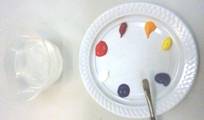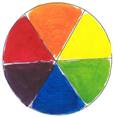The colour circle
Put a small amount of each of the primary colours (red, blue and yellow) on the palette and some white.
As you can see on the palette pictured below there are two of each primary colour. This is because there is a warm and cool version of each. You need a warm and cool version of each primary colour to be able to mix pure secondary colours. See the difference between the green mixed with warm colours and the one mixed with cool colours.
|
|
|
When you are asked to mix colours, the instructions will tell you whether you should be using a warm or a cool primary colour to achieve the purest secondary colour.
|
A colour circle showing the warm and cool primary colours and pure secondary colours |
Notice how similar the blues appear to be. This is because they are both so dark. But when you use them to mix other colours, you will find they have very different properties.



